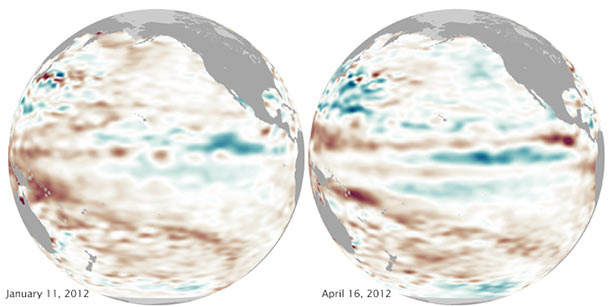La Niña is dead - and good riddance

I am very happy to see a very unwelcome visitor go away: La Niña is dead.
Over time, the pattern of ocean and atmospheric circulation changes. When cooler water in the eastern Pacific Ocean is brought to the surface at the Equator, it's called La Niña, and when that water is warmer it's El Niño. This changes the way winds blow and water evaporates, and during La Niña Australia gets torrential rains and floods, while the US gets drought conditions, especially in the southwest.
This year, the jet stream was also held up near the US/Canada border, so the winter was very mild, and many states suffered severely dry conditions. But finally, after two years, equatorial waters are warming up. As you can see in the image above, the water near the Equator was cooler (blue) in January 2012, and now a stream of warmer water (red) has appeared north of it. This means neutral conditions will take hold (and eventually lead to an El Niño).
All winter here in Boulder it's been far warmer and drier than usual, and in my travels these past few months the story has been the same nearly everywhere. The mountains to my west have been nearly free of snow, something I haven't seen since moving here. But literally, as I type this it's raining steadily outside, again something I haven't seen in many months.
It's very welcome! Well, I'm rather hoping it doesn't interfere with the talk and star party I'm doing in Boulder this coming Saturday, but in the meantime it'll be nice to see the creeks rising, the snow pack increasing, and the trees looking a little bit peppier.
Image credit: NASA Earth Observatory/Jesse Allen and Kevin Ward, using JASON-2 data provided by Akiko Kayashi, NASA/JPL Ocean Topography Team.
Related Posts:
- Sea level rise has slowed⦠temporarily
- What caused the Little Ice Age?
- Saline the ocean blue
- Arctic sea ice will be below average again this year





























